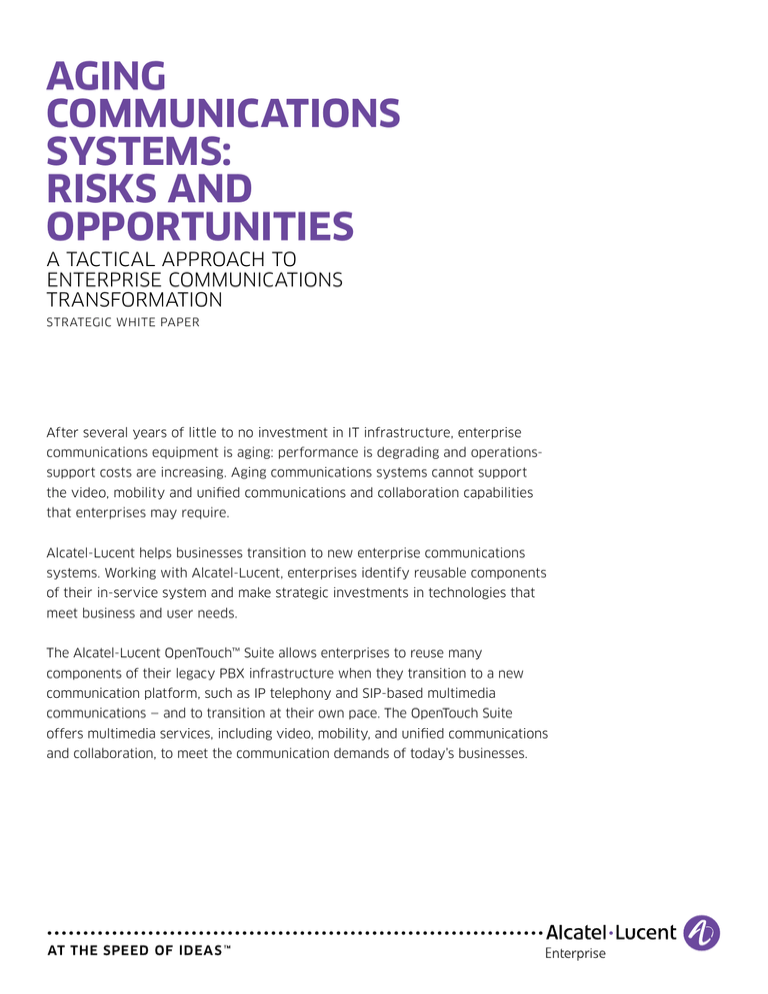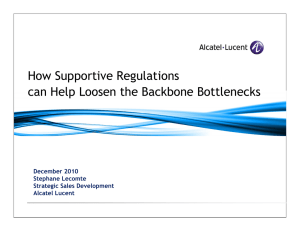
aging
communications
systems:
risks and
opportunities
A TACTICAL APPROACH TO
ENTERPRISE COMMUNICATIONS
TRANSFORMATION
Strategic White Paper
After several years of little to no investment in IT infrastructure, enterprise
communications equipment is aging: performance is degrading and operationssupport costs are increasing. Aging communications systems cannot support
the video, mobility and unified communications and collaboration capabilities
that enterprises may require.
Alcatel-Lucent helps businesses transition to new enterprise communications
systems. Working with Alcatel-Lucent, enterprises identify reusable components
of their in-service system and make strategic investments in technologies that
meet business and user needs.
The Alcatel-Lucent OpenTouch™ Suite allows enterprises to reuse many
components of their legacy PBX infrastructure when they transition to a new
communication platform, such as IP telephony and SIP-based multimedia
communications — and to transition at their own pace. The OpenTouch Suite
offers multimedia services, including video, mobility, and unified communications
and collaboration, to meet the communication demands of today’s businesses.
Table of contents
The state of IP telephony in the enterprise
The myth that old systems are inexpensive
What enterprises need to do
The strategic approach
/
/
3
The Alcatel-Lucent Proposition
CONCLUSION
/
ACRONYMS
9
/
REFERENCES
/
8
9
2
/
5
1
/
/
2
THE STATE OF IT TELEPHONY IN THE ENTERPRISE
Enterprise telephony systems are aging but the current economy does not make replacements or upgrades easy. After a dramatic decrease in 2009, IT spending worldwide is
now on the upswing. However, revisions in forecasts to the overall GDP growth rate for
the coming years suggest this recovery is fragile1.
The private branch exchange (PBX) and office phone-set markets are experiencing the
same trend, with an overall compound annual growth rate (CAGR) of less than four
percent expected from 2012 to 20162. This market was expected to shift rapidly from
TDM to IP; however, the transition has stalled over the past five to ten years.
The average enterprise telecommunications system life cycle is five to seven years,
starting in 2000 (with the Y2K issue). The last five years were predicted to be one of the
most active for telecommunications renewals, corresponding with trends such as bring
your own device (BYOD), “appification3”, “softwarization4” and new go-to-markets based
on cloud technologies.
Even though the adoption of new technologies based on unified communications and
collaboration (UC&C), video and mobility has been increasing since 20115, this move did
not occur as fast as expected because:
• The transition was viewed as complex, requiring multiple technologies that are
sometimes costly and difficult to integrate.
• There was no firm proof that deploying UC&C would provide a return on investment
(ROI).
• Many organizations delayed making capital investments to their networks during the
poor and uncertain economic conditions of recent years.
For several years, during difficult economic times, many organizations have challenged
their IT organization’s requests to invest in new equipment to keep pace with the evolution
of networking. Businesses have shown reluctance to introduce new innovations in their
network, preferring to work with the existing infrastructure. Consequently, many enterprise
communications systems are ageing to the extent they are impacting business operations.
1 Gartner, Forecast Overview: IT Spending, Worldwide, 2009-2016, 1Q12 Update, May 2012.
2 Dell’Oro, ET24A Enterprise Telephony Forecast Report, January 12, 2012 and ET01A Enterprise Telephony Report 1Q12 for updates and
growth rates revision.
3 Appification is the growing trend to create applications to respond to needs and opportunities.
4 The PBX industry is transforming from offering dedicated hardware and proprietary software, embedded in the network, to providing
pieces of software that can be deployed on industry-standard servers, and eventually, virtualized on virtual machines. This process is
called softwarization.
5 According to IDC, 49 percent of enterprises have adopted unified communications. Sources: IDC, Unified Communications 2012 Top
Predictions, 2011 EMEA Attitudes Towards Managed Unified Communications WAN Manager Survey, 2012 EMEA Unified Communications and Collaboration Technology Maturity Bell Curve.
AGING COMMUNICATIONS SYSTEMS: RISKS AND OPPORTUNITIES
Alcatel-Lucent White paper
1
THE MYTH THAT OLD SYSTEMS ARE INEXPENSIVE
Many believe there is no need to replace aging systems as long as they are operational.
This view neglects changes to business needs since the initial technical investments were
made. Also, IT departments must try to provide new services using the older technologies
that were not designed to support them.
This perspective does not take into account changes to the business and new demands
those changes make on the technology infrastructure. IT departments are faced with trying to roll out new services on aging equipment that was not designed to support them.
Underestimated costs
The likelihood of equipment failures increases with aging, and failures are costly. Once
equipment reaches end-of-life, no service level agreement (SLA) agreements for the
equipment are available. Without a service contract, the business has no guarantee of
resolution time or level of priority the equipment supplier will give if an issue arises. If
the business needs to contact the supplier to resolve an issue, it will pay the highest price
to open a case. Full prices in the industry can range between $4,000 and $10,000 per
case, depending on the complexity. Therefore, operating services on equipment that has
no service contract imposes unnecessary risk on the enterprise.
As new standards evolve and business systems are updated, the enterprise also runs the
risk that IT will not be able to implement applications built on top of the aging system.
New standards and protocols will not be compatible with the integration interface of the
enterprise’s aging system.
If aging systems cannot support the new features the business wants, such as personal and
professional contacts integration and rich application integration, employees may begin using
their corporate cell phones instead, inside the enterprise, increasing corporate expenses.
WHAT ENTERPRISES NEED TO DO
Identifying the right time to invest in new enterprise telephony equipment is a difficult
task. Each enterprise will need to do a cost-benefit analysis, comparing the cost of
maintaining the existing infrastructure with the cost of upgrading equipment.
We know that mission-critical systems and applications depend on the technology that
operates them. Consequently, technology decisions are also crucial business decisions.
Including IT personnel in the analysis and decision-making of technology-based activities
can help make better, more strategic decisions for the enterprise, and reduce the risk that
equipment will become obsolete.
IT teams can help enterprises select the most appropriate technologies to meet business
requirements by:
• Identifying how critical the communications system is to the business. If a system is
mission-critical, reliability and security will be a high priority. This is a high priority in
organizations that are driven primarily by processes, such as factories.
• Defining how innovative technologies can contribute to business efficiency. This is a
high priority in organizations driven primarily by the business, such as retail sales.
AGING COMMUNICATIONS SYSTEMS: RISKS AND OPPORTUNITIES
Alcatel-Lucent White paper
2
• Estimating how easily users will adopt the new technology. Organizations are more
effective when users adopt new technologies faster. User reaction can determine a
project’s success. This is a high priority in creative businesses, which are driven largely
by individual behaviors.
When the business and IT collaborate, they will be able to provide the enterprise with a
comprehensive cost-benefit analysis of retrofitting their aging communications system.
To begin this work, we suggest you assess:
• Sustainability of existing IT communications. Identify external factors, such as new
regulations, industry standards and the enterprise’s contractual obligations. These
changes may be achieved more efficiently or effectively with new technology, making
the investment worthwhile.
• Age of the equipment. Verify if the vendor still supports the equipment, and if the
hardware and software components are still compatible with each other. It may be
beneficial to consider the level of risk the enterprise will tolerate.
• Service-level factors of the equipment. Determine if the network is experiencing
decreased performance, availability, reliability or capacity limits; increased
maintenance costs; and if it is difficult to find or retain people with the skills needed
to operate the network. The number of people with expertise in those technologies
decreases as people retire. And younger, new entrants to the work force have no
interest in working in with aging systems. If the service levels are decreasing, the
equipment’s age may be preventing the IT organization from delivering the services
the business needs. Other factors, such as the difficulty of recruiting and retaining
people, suggest that equipment age is causing other non-technical risks to the business.
THE STRATEGIC APPROACH
Conducting the review
There are a number of factors to evaluate when performing a strategic review of the
sustainability of the enterprise’s telephony’s system.
Identify external factors
• Does the business need to comply with regulatory and legislative changes, such as the
Sarbanes-Oxley Act in the United States? These changes may require new processes
and equipment.
• Does the business have new contractual obligations that may provide opportunities?
For example, new contracts may require additional software licensing, making it more
economical to purchase a site license than individual licenses; thereby, allowing IT to
extend the software to everyone in the enterprise.
• Are any service and support contracts about to terminate? Operating without support
contracts increases the risk of system outages, high service costs and delays in issue
resolution.
• Is the enterprise about to embark on any new enterprise-scale projects? These projects
could be the construction of a new building, a new business application deployment,
a new network infrastructure or a company acquisition. Initiatives like these offer the
chance to upgrade enterprise telephony equipment and offer new services, reduce
costs or improve efficiencies.
AGING COMMUNICATIONS SYSTEMS: RISKS AND OPPORTUNITIES
Alcatel-Lucent White paper
3
Define service levels
• Are performance levels decreasing?
• Is the system performance still compliant with internal SLA levels?
• Are users noticing a reduction in performance? Data from the trouble tracking system
may help to find answers to these questions. Do employees complain about not being
able to call colleagues because the lines are busy? Are they easily able to call someone
who is listed in the enterprise’s directory of telephone and email contacts?
• Is the system operating close to system capacity — can you add dozens of new users
before needing to install more hardware or software components?
Meet business expectations
• Have business conditions, requirements and expectations changed? For example,
users might be using cell phones instead of desk phones. If the cell phones are not
integrated with the company’s communications system, the security deployed in
the communications system will be bypassed, and security compromised because
conversations will not be encrypted. A lack of integration can also result in higher
OPEX because the enterprise will not benefit from the system’s least cost routing (LCR)
capabilities.
• Is the communications system meeting user expectations? Changes to the business can
change users’ telephony requirements. An acquisition may require people in different
locations to communicate regularly. New governance models may require a larger
number of people to make decisions.
• Have your competitors changed how they communicate with customers?
Implications of aging equipment
• Are operational costs increasing? This is an indicator of an aging system.
• Is the number or the severity of issues increasing? The equipment may be operational
but cause other networking problems. New components may not be compatible with
the aging equipment. Eventually, your operating system and software will not run on
servers you need to purchase.
Collecting this information is a complex activity and takes considerable effort; however,
the work will provide valuable information to make strategic decisions.
Choosing the right direction
Aging systems increase operational costs and can generate new, uncontrolled costs
caused by unmanaged network consumption by users. At the same time, the risk of
major failures increases, leading to less availability and potential interruptions in the
business. Eventually, it becomes necessary to upgrade the communications system.
A system upgrade offers an opportunity to plan and anticipate future needs, consider
tools to improve productivity, and to optimize the communications infrastructure. This is
an opportune time to address the business needs, such as ensuring that the solution:
• Is compliant with the company’s business continuity plans
• Provides more flexible communications so users can operate multiple devices —
potentially their own — and telecommute
AGING COMMUNICATIONS SYSTEMS: RISKS AND OPPORTUNITIES
Alcatel-Lucent White paper
4
• Delivers a rich conversation experiences while protecting previous investments
• Democratizes the use of high definition (HD) video to help a distributed organization
collaborate better by providing employees with video collaboration tools, such as video
conferencing for the desktop
The transformation path should offer ways to:
• Diminish the level of risk
• Decrease operational expenses
• Re-allocate operational savings to budgets for innovation
• Introduce a roadmap for evolution
• Anticipate the costs of future upgrades
• Define new models for delivering communications services to lines of business or
directly to end users
The transformation strategy is a good time to define or update the IT strategy. Even
enterprises whose IT organizations are focused on avoiding risk can offer strategic recommendations and introduce innovation in the communication infrastructure at this time.
THE ALCATEL-LUCENT PROPOSITION
Alcatel-Lucent Enterprise can accompany organizations through a transformation path,
refreshing the components of the enterprise communications systems and meeting
current business needs.
The Alcatel-Lucent OpenTouch™ Suite of solutions is flexible, allowing a company to
reuse elements of the in-service system, such as a legacy PBX, and building an updated
system that can last for years without becoming obsolete.
Review what’s of value
Aging systems are costly, and create risks, but they may contain reusable components
that can reduce transformation costs.
IP transformation makes sense for very dynamic organizations, where the savings on
operational costs balances the IP investment. However, if employee moves are rare, there
is no need to replace TDM phones with IP or Session Initiation Protocol (SIP) phones. It
may also make sense to keep some components, such as DECT or wireless LAN (WLAN)
infrastructure, and the contact center.
An enterprise needs to consider the costs of a massive rip-and-replace approach because
these costs are often underestimated. The training for IT teams to be skilled on a new
system can take 25 days for each engineer (industry average). Users will spend an average
of three hours to learn how to use the new interface. By comparison, updating an existing
system costs an average of two to five days for IT staff and has little impact to employees.
Alcatel-Lucent helps enterprises revive the components of their communications system
that have value, and update only what makes sense. An existing Alcatel-Lucent system,
such as the Alcatel-Lucent OmniPCX 4400 or an Alcatel-Lucent OmniPCX™ Enterprise
Communication Server (CS) PBX, can be transformed to the latest version of the
AGING COMMUNICATIONS SYSTEMS: RISKS AND OPPORTUNITIES
Alcatel-Lucent White paper
5
OmniPCX Enterprise CS. Valuable assets such as telephone sets and existing cabling can
be reused. The new system becomes the starting point for future evolution because it is
the foundation of the Alcatel-Lucent OpenTouch Suite offering.
Understand what’s at stake for your business
The latest version of the OmniPCX Enterprise CS guarantees high availability. Its
redundancy capabilities ensure business continuity, and disaster recovery plans can be
put in place to meet company standards. The solution is compliant with most industry
standards and regulations. For example, it is widely used in large banks that need to
comply with Sarbanes-Oxley regulations.
Enterprises can optimize deployments and data centers with the virtualization capability of the OmniPCX Enterprise CS. Its flexible architecture permits a high degree of
centralization. Therefore, IT can realize substantial savings on operations by reducing
the number of systems and locations. A single point of management is also provided to
simplify operations.
Alcatel-Lucent can provide enterprises with a set of communications tools, such as native
conferencing capabilities that support mixed media, and allow users to move freely to
any device during the same conversation.
Employees will be able to collaborate from any location — home, office or on the
move — using the device of their choice, without disruption or compromise to quality or
security. With easy real-time access to their business community and the ability to share
documents and work on them collaboratively in real time, employees will improve their
productivity and be able to react more quickly to meet business requirements.
The Alcatel-Lucent OpenTouch Suite offers flexible deployment modes, so IT departments can deliver a high standard of collaboration experiences from the enterprise data
center or through cloud-based services.
Move toward business efficiency
Alcatel-Lucent offers flexible scenarios to transition the enterprise communications system. The enterprise begins by updating their aging system to the latest version to provide
a standard level of service that meets the expectations of the business and of IT — back
to 99.999% reliability. Table 1 lists the transformation steps in the transition.
AGING COMMUNICATIONS SYSTEMS: RISKS AND OPPORTUNITIES
Alcatel-Lucent White paper
6
Table 1. Transition steps
Steps
Benefits
1. Move to the latest version.
•
Keep what’s of value.
•
•
•
Total cost of ownership (TCO)
Savings on training
Has been adapted to new standards
2. Optimize the network based on the latest system version.
•
•
•
•
•
Migrate from TDM to IP when it makes sense,
for example, if employees move a lot.
Reduce the number of nodes by centralizing
what makes sense.
Reshape the network’s infrastructure to
optimize on-net and off-net traffic.
Use virtualization in data centers for better
resource allocation.
Deploy a unified management platform.
•
•
•
•
Reduced operational times (some enterprises
have decreased their operations time by as
much as 40% by implementing centralized
management)
Simplify network management
Simplify provisioning, and moves, adds,
changes and deletions (MACD)
Lower communications bills by
approximately 10% to 20%
3. Innovate to improve efficiency based on the latest system version
•
•
•
Give mobile workers — home office
telecommuters or road warriors — access to
the same functionality offered at the office.
Enrich the employee experience with
multimedia collaboration capabilities.
Deliver that experience on any device
with a series of apps dedicated to each
environment: desk phones, PCs, smartphones
or tablets and in-room video equipment.
•
•
•
•
A seamless experience anytime, anywhere,
on any device
Wider user adoption
Simplified remote teamwork
Improved productivity that increases
business efficiency
Evolve at your own pace
The Alcatel-Lucent OpenTouch Suite is composed of:
• A range of communications platforms designed to address different needs and markets,
from pure IP telephony to rich, SIP-based, multimedia communications switching, in
distributed or centralized modes, on customer premises equipment (CPE) or in hosted
environments
• A series of communications applications to address business telephony, UC&C,
mobility, video conferencing, video sharing, customer interactions and unified
management needs
• A complete set of client applications and devices to deliver the conversation experience
to users in the most suitable way: desk phones (TDM, IP or SIP), smart desk phones
that are application capable, campus roaming solutions, dedicated video devices,
interactive whiteboards, and a collection of applications dedicated to smartphones,
tablets and PCs
To make the transition as smooth as possible and remove the risks of aging, AlcatelLucent systems are sold with multiyear evolution contracts. This allows you to choose
how to evolve toward an optimization or innovation scenario, with predictable pricing,
when it makes sense to your business.
AGING COMMUNICATIONS SYSTEMS: RISKS AND OPPORTUNITIES
Alcatel-Lucent White paper
7
CONCLUSION
After several years of little or no investment in telephony equipment, enterprise communications systems are aging to the point that performance is degrading, operational
support costs are increasing, and the systems are not meeting business needs. Enterprises
are finding their equipment is no longer supported by the manufacturer, further increasing business risk and expenses in the event of failures.
Businesses can prevent these risks and associated costs if IT organizations play a more
strategic role in the enterprise. The key is to get the maximum use from the technology
and to replace it before performance degrades beyond acceptable levels (when the equipment is no longer supported), to avoid the risk of long outages and expensive repairs.
The Alcatel-Lucent OpenTouch Suite allows you to reuse many components that are
already part of the legacy PBX infrastructure. It provides a flexible transition plan to
migrate to IP when it makes sense to the business, and offers multilayer evolution
contracts to remove the risks of aging technologies.
The OpenTouch Suite supports a variety of platforms, such as IP telephony and SIP-based
multimedia communications. It includes several multimedia applications, such as video,
mobility, and unified communications and collaboration, and offers client applications and
devices to meet the communication behaviors of today’s businesses, including TDM, SIP
and IP desk phones, video devices, and applications for smartphones, tablets and PCs.
The OpenTouch Suite also provides high availability and redundancy, to meet the enterprise’s business continuity and disaster recovery plans. And because the suite is flexible,
you can decide to implement features and capabilities when it makes good business sense.
AGING COMMUNICATIONS SYSTEMS: RISKS AND OPPORTUNITIES
Alcatel-Lucent White paper
8
ACRONYMS
BYOD
bring your own device
CAGR
compound annual growth rate
CPE
customer premises equipment
DECT
Digital European Cordless Telecommunication
GDP
gross domestic product
HD
high definition
IP
Internet Protocol
IT
information technology
LCR
least cost routing
MACD
moves, adds, changes and deletions
PBX
private branch exchange
ROI
return on investment
SIP
Session Initiation Protocol
SBC
session border controller
SLA
service level agreement
TCO
total cost of ownership
TDM
Time Division Multiplexing
UC&C
unified communications and collaboration
WLAN
wireless local area network
REFERENCES
1.Alcatel-Lucent Enterprise. Backgrounder: At a Glance: Alcatel-Lucent Enterprise, 2012.
http://enterprise.alcatel-lucent.com/docs/?id=21327
2.Alcatel-Lucent Enterprise. Brochure:
Alcatel-Lucent Enterprise: Your Partner to Change the Conversation, March 2012.
http://enterprise.alcatel-lucent.com/docs/?id=18972
3.Alcatel-Lucent Enterprise. Business White Paper: Enabling Real-Time Business
Conversations That Span Locations and Devices, 2011.
http://enterprise.alcatel-lucent.com/docs/?id=19142
4.Alcatel-Lucent Enterprise. Research White Paper:
Changing the Conversation in the Workplace, 2011.
http://enterprise.alcatel-lucent.com/docs/?id=19776
5.Alcatel-Lucent Enterprise. Use Cases: Business Collaborative Conversation Scenarios, 2011.
http://enterprise.alcatel-lucent.com/docs/?id=18042
6.Dell’Oro ET24A Enterprise Telephony Forecast Report, January 12, 2012.
7.Dell’Oro. ET01A_Enterprise_Telephony_Report_1Q12 for updates and growth rates
revisions.
8.Gartner. Forecast Overview: IT Spending, Worldwide, 2009-2016, 1Q12 Update, May 2012.
http://www.gartner.com/id=1886414
9.IDC. EMEA WAN Manager Survey, 2011.
www.alcatel-lucent.com Alcatel, Lucent, Alcatel-Lucent and the Alcatel-Lucent logo are trademarks of
Alcatel-Lucent. All other trademarks are the property of their respective owners. The information presented
is subject to change without notice. Alcatel-Lucent assumes no responsibility for inaccuracies contained herein.
Copyright © 2012 Alcatel-Lucent. All rights reserved. E2012074857 (August)






